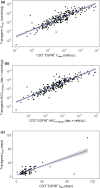In Vivo Cellular Expansion of Lisocabtagene Maraleucel and Association With Efficacy and Safety in Relapsed/Refractory Large B-Cell Lymphoma
- PMID: 35156195
- PMCID: PMC9311712
- DOI: 10.1002/cpt.2561
In Vivo Cellular Expansion of Lisocabtagene Maraleucel and Association With Efficacy and Safety in Relapsed/Refractory Large B-Cell Lymphoma
Abstract
Lisocabtagene maraleucel (liso-cel) is an autologous, CD19-directed, chimeric antigen receptor T-cell product for the treatment of adult patients with relapsed or refractory large B-cell lymphoma (LBCL) after 2 or more lines of systemic therapy. In vivo cellular expansion after single-dose administration of liso-cel has been characterized. In this article, in vivo liso-cel expansion in the pivotal study TRANSCEND NHL 001 (ClinicalTrials.gov identifier, NCT02631044) was further characterized to assess the relationship between in vivo cellular expansion after single-dose administration of liso-cel and efficacy or safety after adjusting for key baseline characteristics. Two bioanalytical methods, quantitative polymerase chain reaction and flow cytometry, were used for the assessment of cellular kinetics of liso-cel, which showed high concordance for in vivo cellular expansion. Multivariable logistic regression analyses demonstrated that higher in vivo cellular expansion of liso-cel was associated with a higher overall response and complete response rate, and a higher incidence of cytokine release syndrome and neurological events in patients with relapsed or refractory LBCL. Age and tumor burden (by sum of the product of perpendicular diameters) were likely to confound the relationship between in vivo cellular expansion and efficacy, where the association became stronger after controlling for these factors. Repeat dosing of liso-cel was tested in the study; however, in vivo cellular expansion of liso-cel was lower after repeat dosing than after the initial dose. These findings should enable a comprehensive understanding of the in vivo cellular kinetics of liso-cel and the association with outcomes in relapsed/refractory LBCL.
© 2022 Bristol Myers Squibb. Clinical Pharmacology & Therapeutics published by Wiley Periodicals LLC on behalf of American Society for Clinical Pharmacology and Therapeutics.
Conflict of interest statement
K.O., J.L., T.M., J.D., C.H., J.S., L.P., and A.K. are employees of Bristol Myers Squibb and hold stock in Bristol Myers Squibb.
Figures






Comment in
-
Quantitative Clinical Pharmacology of CAR T-Cell Therapy.Clin Pharmacol Ther. 2022 Jul;112(1):11-15. doi: 10.1002/cpt.2631. Clin Pharmacol Ther. 2022. PMID: 35716389 No abstract available.
References
-
- Pagel, J.M. & West, H.J. Chimeric antigen receptor (CAR) T‐cell therapy. JAMA Oncol. 3, 1595 (2017). - PubMed
-
- Turtle, C.J. Chimeric antigen receptor modified T cell therapy for B cell malignancies. Int. J. Hematol. 99, 132–140 (2014). - PubMed
-
- Turtle, C.J. , Riddell, S.R. & Maloney, D.G. CD19‐targeted chimeric antigen receptor‐modified T‐cell immunotherapy for B‐cell malignancies. Clin. Pharmacol. Ther. 100, 252–258 (2016). - PubMed
-
- Holstein, S.A. & Lunning, M.A. CAR T‐cell therapy in hematologic malignancies: a voyage in progress. Clin. Pharmacol. Ther. 107, 112–122 (2020). - PubMed
Publication types
MeSH terms
Substances
Associated data
LinkOut - more resources
Full Text Sources
Medical

